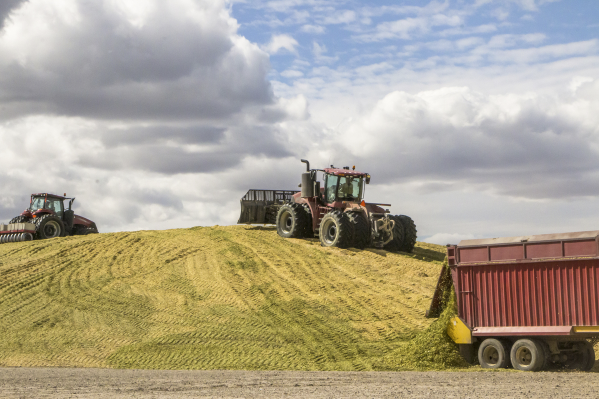Almost every dairy samples and analyzes their forages, commodities and feed at some point in time. It is generally recognized that collecting this information periodically is necessary for proper development and formulation of the various feeds used on the farm.
It is also important information to have for making the necessary diet adjustments as nutrients, digestibility, forage and ingredient sources change.
A major part of this is the needed focus on reducing variability and maintaining consistency of feed and nutrient intake. This is a huge challenge that is always present and accounts for a tremendous drain on overall performance and profitability. Consistency issues are pervasive throughout the typical dairy operation. There is hardly an area of the dairy that cannot be adversely affected by challenges to consistency. Adequate management and best possible control of the many variable components is difficult on the best of days.
The lactating dairy cow does not deal well with change or variation, especially when it comes to the feed/nutrient flow into the rumen and downstream from there. Remember, the lactating cow is a “continuous flow” production system. For the mammary gland to produce consistently, depending on the stage of production, the nutrient flow into the animal must be adequate or optimal. This is a prerequisite particularly as we focus on performance efficiency.
A properly designed and implemented Forage and Ingredient Sampling and Analysis Program (FISAP) is necessary for managing and controlling the nutrition component variation on-farm. Done properly and extensively, there is a significant cost involved. This can be incorporated as part of the overall nutrition program and can be built into feed costs. Of course, every farm needs to manage these expenses in the manner that works best.
Developing the FISAP
Since most dairies have at least some sort of a sampling and analysis program, there will not be many that have to start from nothing. But for the sake of discussion, we will start at the beginning.
- The first part of this program is sitting down with your nutritionist to discuss what they need or recommend to properly develop and maintain the diets used on the dairy. How often do they modify the feeds? Is it on a set schedule or based on known variables (i.e., changes in silage dry matter levels)?
- Working with your nutritionist, develop sampling protocols, procedures and schedule. Ingredient sampling needs to be a regular part of daily operations. Use good sampling techniques to ensure representative samples.
- Decide on what forages and ingredients need to be sampled and how often. For ingredients like corn or grass silages, moisture should be tested daily and the ration adjusted as necessary to maintain dry matter intake (DMI) consistency. For high-moisture ingredients (high-moisture corn as well as high-moisture byproducts such as distillers grain, gluten feed, brewers grains, vegetable waste, etc.), closely monitoring dry matter content is a key to keeping ration dry matter levels stable. Variation in ration dry matter can have a significant effect on milk volume as well as components. Fortunately, this can be monitored and adjusted on-farm on a day-to-day basis fairly easily with use of the feeding software currently available.
- A variety of moisture testing methods are available.
- Silages should be tested periodically for more extensive data including protein and protein components, fiber and carbohydrate components, minerals, etc.
- Other ingredients such as grains, etc., should also be tested periodically. While grains and proteins such as corn and soybean meal are fairly consistent, some variation can exist. Byproducts are the biggest concerns. Byproducts such as dry distillers grains (DDGs) and corn gluten feed can vary quite a lot depending on source but also from a given source. Work with suppliers to gather and track nutrient data. If the supplier can supply real-time analyses, these should be obtained as well.
- Periodically, test TMRs as well as premixes and supplement mixes. This helps ensure feeds are being mixed properly and purchased mixes are made to specifications. Additionally, some additive companies have assays that can detect their material. Sampling the premix or the TMR and having the company run their assay can also be used to determine mixing accuracy.
- Develop a database of assay data for each forage source or ingredient. This can be used to develop a baseline for nutrient values of different ingredients for future comparisons. It can also be a reference point when changes in production or components are noted.
- Work with one or more labs that are known to be accurate, have a quick turn-around time, can provide the analyses needed for the dairy’s specific program and are cost-effective. There are many different analytical labs available. A list of these can be found on the National Forage Testing Association website (www.foragetesting.org). Many labs can provide the results in a form that can be downloaded into formulation systems. In any case, the time from sample collection to results availability should be as short as possible for the data to be relevant and useful.
The most important parts of a sound FISAP program are thinking it through thoroughly and then making good, timely use of the results. Give careful thought to how the program will be incorporated and managed in day-to-day operations. Given the rapidness of ingredient use, test results have a short shelf life. They need to be incorporated quickly or else the supply of that ingredient may be gone.
Obviously, this is a brief discussion of developing and implementing a FISAP program. Every dairy is different, so every sampling and analyses program is different and needs to be individually designed to meet the farm’s needs. In today’s dairy economy, done correctly, it can make the difference between profiting or working in the red.












